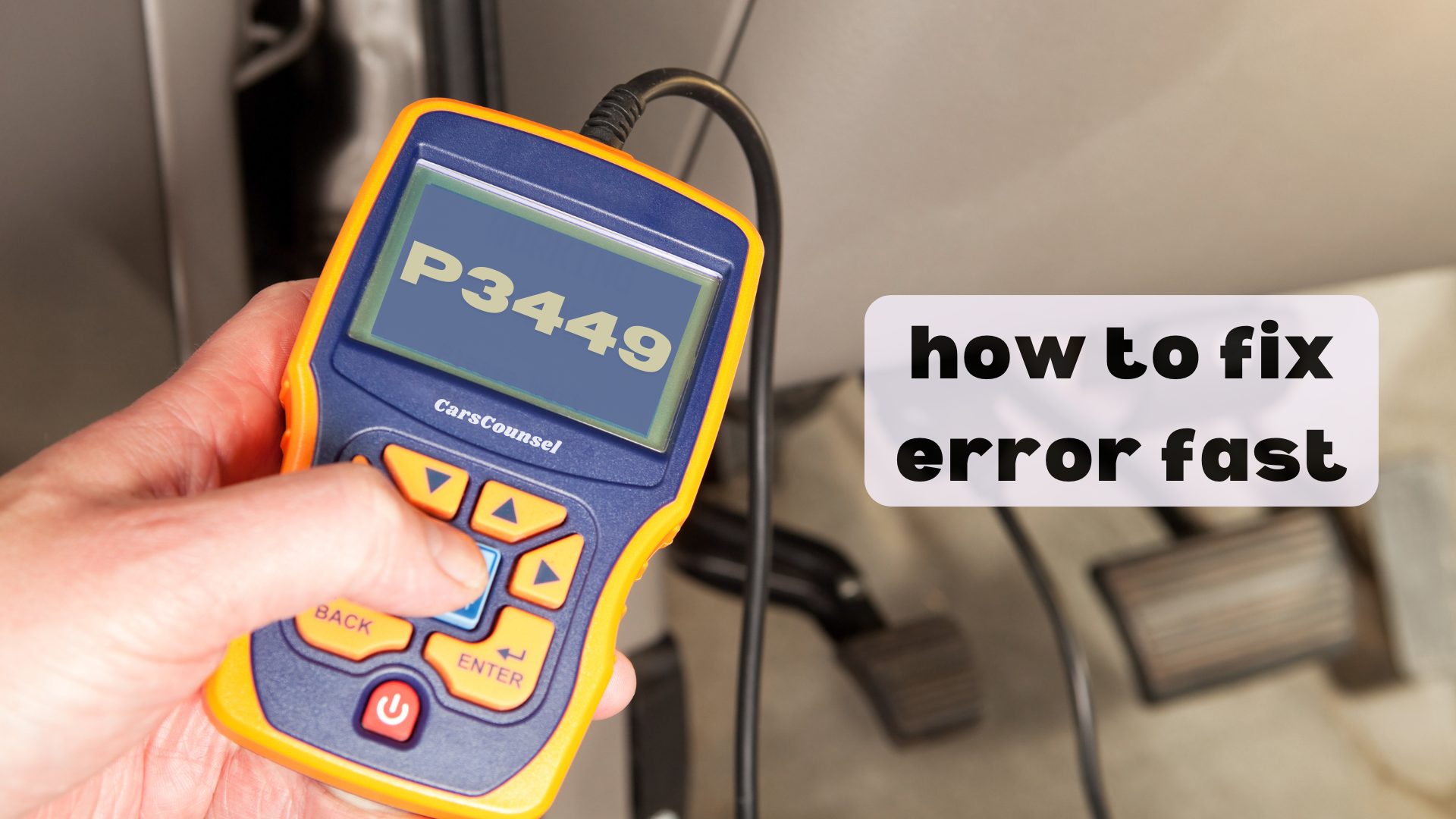You might not know that the P3449 code often points to problems with your vehicle’s intake valve control circuit, specifically affecting cylinder deactivation.
If you’re dealing with this error, you can fix it quickly by using an OBD-II scanner to get the trouble codes, checking vacuum lines for leaks, and inspecting the solenoid and wiring for any damage.
It’s important to replace any faulty parts and clear the error codes before testing your vehicle again.
Want to make sure this problem doesn’t come back? Let’s talk about the steps you can take and how to prevent it in the future.

Quick Navigation
Key Takeaways
- Use an OBD-II scanner to read the P3449 code and any other related codes.
- Check the cylinder deactivation solenoid and control circuit components for any faults and replace them if needed.
- Look over the wiring and connectors in the control circuit for any damage or corrosion and fix them.
- Make sure that oil passages and vacuum lines are clear and working properly.
What Is the P3449 Code?
Ever wondered what the P3449 code means in your car’s diagnostic system? This code is related to the engine’s intake valve control circuit, especially in engines that use cylinder deactivation. When you see this code, it means there’s a problem with how air and fuel are managed, which can mess with your engine’s performance. You’ll notice the check engine light (CEL) comes on, and the code is stored in the car’s computer.
To fix it, you should look at the intake valve control solenoid and the related wiring. This involves checking for damaged wires, faulty solenoids, and making sure the cylinder deactivation system is working properly.
Fixing these issues will help get your engine running smoothly and improve fuel efficiency.
Symptoms of P3449 Code
When the P3449 code shows up, you might notice symptoms like rough idling, lower engine performance, and higher fuel consumption.
To check for more engine problems, watch out for engine misfires and strange noises from the engine area.
Here are some tips to troubleshoot the P3449 code:
First, make sure the check engine light (CEL) is on.
Then, use an OBD-II scanner to confirm the P3449 code.
Look at the intake valve control circuit to see if there’s any obvious damage.
Check if the cylinder deactivation system is working okay.
Also, check for oil pressure issues, as these can make things worse.
Lastly, listen for any odd engine sounds that might indicate bigger problems.
Fixing these issues quickly can help prevent more damage and keep your engine running well.
Common Causes of P3449
A bad intake valve control solenoid is a main cause of the P3449 code and can mess up the engine’s cylinder deactivation system. This problem can throw off the air and fuel mix, hurting engine performance.
Here are some common reasons for this issue:
- Broken wires or connectors: Check if there are any frayed wires or loose plugs in the control circuit.
- Bad cylinder deactivation solenoid: Make sure the solenoid that controls cylinder deactivation is working right.
- Problems with the engine control module (ECM): Look for issues in the ECM since it manages the valve control system.
Fixing these problems quickly will help get your engine running well again and avoid more issues.
Affected Car Models
Understanding the common causes of the P3449 code can help identify which car models are more likely to have this problem. Affected models include the Honda Accord with V6 engines, which often have issues with the VTEC solenoid.
Toyota Camry V6 models may experience problems with the VVT-i oil control valve. Acura MDX V6 engines frequently face issues with the VTEC oil pressure switch.
To reduce these risks, follow these maintenance tips: regularly check solenoids and control valves for wear, ensure wiring and connectors are in good shape, and keep oil levels proper.
Also, stick to the manufacturer’s recommended service intervals. These steps can help prevent the P3449 code from triggering, keeping your car in top condition and avoiding expensive repairs.
Diagnosing the P3449 Code
Diagnosing the P3449 Code
Start by connecting an OBD-II scanner to read the trouble codes from the engine control module (ECM). Use your diagnostic tools to find any issues affecting engine performance.
- Check oil pressure and engine oil levels: Make sure they match the manufacturer’s specifications.
- Inspect VVT system components: Look for any damage or problems in the variable valve timing system.
- Review service history: Look for any past repairs that might give you clues.
These steps will help you find the root cause of the P3449 code, ensuring you address all possible issues affecting your engine’s performance. Proper diagnosis is crucial for effective and efficient repairs.
Using an OBD-II Scanner
Plug in the OBD-II scanner under the dashboard to access the engine control module (ECM) and get the stored trouble codes. Make sure the car is turned on, then follow these steps:
- Connect the OBD-II scanner: Find the 16-pin connector, usually under the driver’s side dashboard.
- Read the codes: Use the scanner’s interface to go to the diagnostic menu and select ‘Read Codes.’
- Analyze the results: Write down the P3449 code and any other codes you see.
| Step | Description |
|---|---|
| Connect Scanner | Find and plug into the OBD-II port |
| Read Codes | Go to the menu and choose ‘Read Codes’ |
| Analyze Results | Write down the P3449 code and other codes |
Using an OBD-II scanner helps you diagnose issues accurately, which is essential for fixing problems effectively.
Checking Oil Pressure
To check the oil pressure, make sure the engine is off.
Find the oil pressure sensor on the engine block. Disconnect the sensor’s electrical connector and hook up a mechanical oil pressure gauge. Start the engine and look at the gauge. Make sure the readings match what the manufacturer says they should be.
Keep an eye on these points for accurate results:
- Engine Idle Pressure: Check the pressure when the engine is idling.
- Increased RPM: Measure the pressure when you rev the engine higher.
- Cold Start: Check the pressure when the engine is cold.
If the readings aren’t within normal ranges, there could be blockages or parts that are wearing out.
Make sure the gauge is properly calibrated for accurate readings and compare them with the vehicle’s specifications.
Inspecting Wiring and Connectors
Start by visually checking the wiring and connectors for any signs of wear, damage, or rust that could mess with the intake valve control circuit.
First, disconnect the battery to stay safe from electrical shocks.
Look closely at each wire for fraying, breaks, or burns that could affect the wiring.
Then, check the connectors for rust or loose connections.
Use a multimeter to see if there’s a continuous flow in any wires you’re unsure about.
Clean any rusty connectors with electrical contact cleaner and a brush.
Make sure all connectors are tightly attached and dry.
Reconnect the battery and use an OBD-II scanner to clear any trouble codes.
Take the vehicle for a test drive to make sure the P3449 code doesn’t come back.
Repair Solutions for P3449
After checking and fixing any damaged wires and connectors, replace any bad solenoids to fix the P3449 code error. Replacing the solenoid is crucial for the engine to work properly. Here’s what to do:
- Disconnect the battery to avoid any electrical issues.
- Find the faulty solenoid using your car’s service manual.
- Remove the bad solenoid and put in the new one, making sure all connections are tight.
Vacuum leaks can mess up the air and fuel balance, causing more problems.
By fixing these areas step by step, you’ll get your engine running smoothly again.
Preventive Measures
Regular upkeep is key to stopping the P3449 code from coming back and keeping your engine running its best. Follow these simple maintenance tips to boost performance and avoid expensive fixes.
- Check oil levels often.
- Look over wiring and connectors for any damage.
- Clean or replace the intake valve control solenoid.
- Make sure vacuum lines are intact and don’t leak.
- Stick to the manufacturer’s service schedule.
Here’s a quick reference table:
| Task | How Often |
|---|---|
| Check oil levels | Every 3,000 miles |
| Check wiring/connectors | Twice a year |
| Clean solenoid | Once a year |
| Check vacuum lines | Once a year |
| Follow service schedule | As per manual |
These steps help keep your engine in top shape and improve performance.
More OBD-II Codes
Frequently Asked Questions
Can Driving With the P3449 Code Cause Long-Term Engine Damage?
Driving with the P3449 code can harm your engine over time. It hurts how well your engine runs. Use diagnostic tools to find and fix the problem right away. Follow clear steps to replace any bad parts and stop more damage from happening.
Does the P3449 Code Affect the Vehicle’s Emissions?
Yes, the P3449 code affects your vehicle’s emissions. Use diagnostic tools to find the problem. Fixing faulty parts quickly prevents more emissions, ensures you follow the rules, and keeps your engine running well.
How Much Does It Typically Cost to Fix the P3449 Code?
Fixing the P3449 code can cost different amounts depending on what’s needed. Usually, replacing solenoids or fixing wiring can cost between $150 and $500. Make sure to get a detailed cost estimate from your mechanic.
Can Low Engine Oil Trigger the P3449 Code?
Yes, low engine oil can cause the P3449 code to appear. Make sure your oil level is correct to keep your engine running well. Regularly check and top off the oil to avoid problems with your intake valve control system.
Are There Any Temporary Fixes for the P3449 Code?
It’s like putting a quick patch on a leaky pipe. Temporary fixes include resetting the car’s computer, making sure the oil levels are good, and checking the wiring for any obvious issues. These steps might give you a bit more time.
Conclusion
You can tackle the P3449 code quickly and easily.
Use your OBD-II scanner to get the codes, check vacuum lines for leaks, and make sure the solenoids are working.
Don’t forget to look at the wiring for any damage.
After replacing any faulty parts, clear the codes and take your car for a test drive.
Keeping up with regular maintenance ensures your vehicle runs smoothly.

